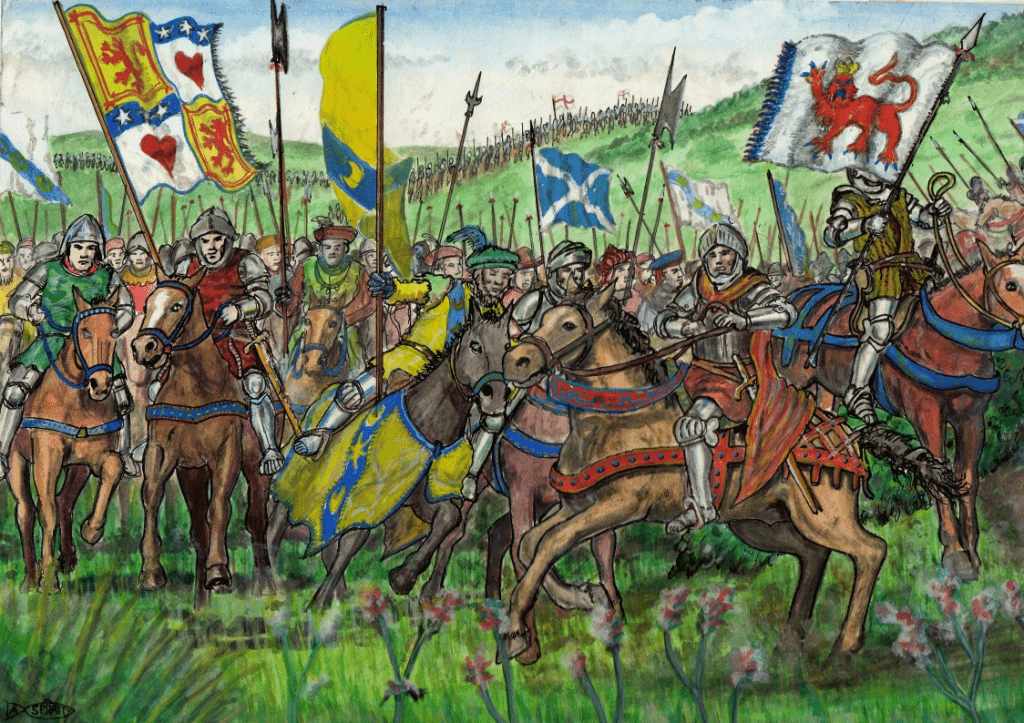History of the Stewarts | Battles and Historic Events
If you are a Stewart Society Member please login above to view all of the items in this section. If you want general information on how to research your ancestors and some helpful links - please look in background information.
If you have a specific question you can contact our archivist.
The Battle of Ancrum Moor
27th February 1545

Henry ordered the Earl of Hertford to devastate Edinburgh, Leith and many other towns. Hertford laid waste to much of southern Scotland in two expeditions in 1544, burning Edinburgh in May in an effort to persuade the Scots to change their minds.
In 1545, an English army under Sir Ralph Eure continued to pillage in the borders. The attacks had forged an unlikely alliance between the Earl of Arran, Regent for the infant Mary, and the Earl of Angus. These two Scottish nobles had been bitter rivals for many years, and had even fought a pitched battle in the streets of Edinburgh in 1520. However, Angus´s estates had suffered during the recent English raids and his family tombs at Melrose Abbey had been vandalised by Eure. Angus learned that Eure had been granted some of his lands in the Scottish borders by Henry VIII. Internal Scottish politics were set aside for the time being. Arran and his rival for power Mary of Guise were reconciled with the Earl of Angus and his brother George Douglas of Pittendreich at the Parliament of Scotland in December 1544.
The Scottish army consisted initially of between 300 and 1,000 men under Angus, and a similar number of troops from Fife under George Leslie, 4th Earl of Rothes and Norman Leslie, Master of Rothes. They were joined by borderers under Scott of Buccleuch. Together, they moved to confront the English army near Jedburgh in the Borders. The battle took place on February 27 1545.
The English army consisted of 3,000 German and Spanish mercenaries, 1,500 English Borderers under Sir Brian Layton and 700 Scottish borderers. As they settled into an encampment under Gersit Law, a small Scottish force made a feint attack and then retreated southwest towards Palace Hill. Much of the English force followed in pursuit. As they crossed the top of Palace Hill and chased down the far side, they found that the whole Scottish army had been hidden on the far side of the hill. The Scots had the advantage of surprise, and of the setting sun which was behind them, dazzling the English, and of the westerly wind which blew gunpowder smoke from arquebuses and pistols towards the English. A charge by Scottish pikemen drove the English back. Then the longer Scottish pikes were used to advantage.
The ground was too uneven for the English to rally at the top of Palace Hill. As they tried again to rally on the eastern slope, the Scottish Borderers with them tore off the red crosses which signified their adherence to England. The English army broke and was forced to scatter through a hostile countryside.
The English lost 800 men killed (including Eure and Layton) and 1,000 taken prisoner. This temporarily stopped their harrying of Scotland. News of the victory also persuaded Francois I of France to send troops to aid the Scots, although they achieved little. The war came to an end shortly afterwards on the death of Henry VIII, only to break out again with perhaps even more violence when Hertford, now Protector Somerset ruling on behalf of Edward VI, sought to impose his own political and religious settlement on Scotland.
A monument on the site of the battle, also known as Lilliard´s Edge,has the following traditional verse:
Fair maiden Lilliard
lies under this stane
little was her stature
but muckle was her fame
upon the English loons
she laid monie thumps
and when her legs were cuttit off
she fought upon her stumps.
- AD 1544
The monument was erected in the 19th century, although it replaced an earlier stone Lilliard is said to have fought at the battle following the death of her lover. Sadly, her story is entirely apocryphal, as the name of the location is recorded as "Lillesietburn" in the 12th century, and as "Lillyat Cros" in 1378. The verse itself is based on the earlier English border ballad of Chevy Chase

